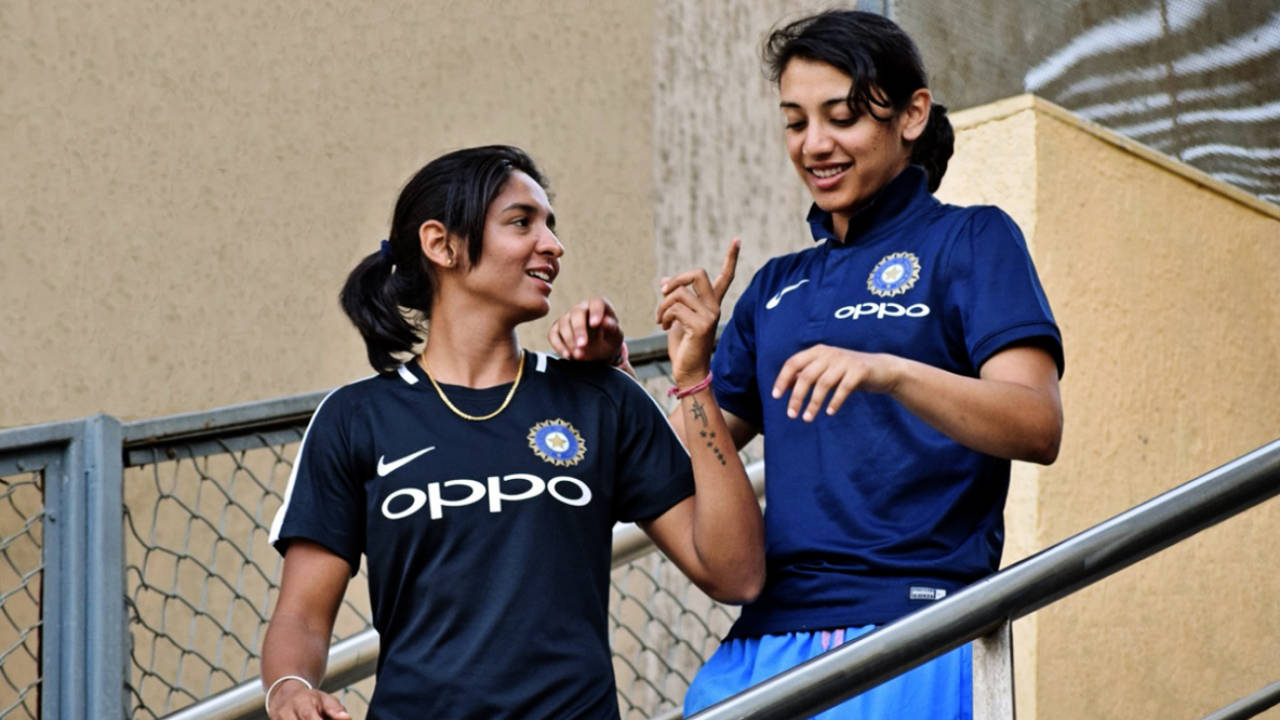Mandhana's KSL feats down to 'freedom to swing bat' - Harmanpreet
Smriti Mandhana smacked 421 runs in nine innings. That is the most runs by a player in a women's T20 league anywhere in the world
Annesha Ghosh
26-Aug-2018
Rehab mates: Harmanpreet and Mandhana, captain and vice-captain of India's T20I team, spent quality time with each other while recovering from injuries at NCA • Annesha Ghosh/Annesha Ghosh/ESPNcricinfo Ltd
In her maiden Kia Super League season, Smriti Mandhana smacked 421 runs in nine innings. That is the most runs by a player in as many innings in a women's T20 league anywhere in the world. The next-best tally belongs to Australia captain Meg Lanning, 405 at the inaugural Women's Big Bash in 2015-16.
While Mandhana herself admitted she "did not expect" to be so prolific, India T20I captain Harmanpreet Kaur, who debuted the same year as Mandhana in both the WBBL and the KSL, put her deputy's performance down to the "freedom to swing her bat".
"Smriti is someone in the Indian side I discuss a lot of cricket with," Harmanpreet told ESPNcricinfo after returning from England, where her side Lancashire Thunder were eliminated in the league stage. "When I met her in the UK, she said her team [Western Storm, who will be defending their title on Finals Day on Monday] had given her the freedom to swing her bat. And it was clear usko mazaa aa raha tha [she was enjoying herself]."
Among the many causalities that the Mandhana juggernaut claimed in the KSL was Harmanpreet's own side, which lost both their home and away games to Storm. While Harmanpreet announced her belated arrival in the tournament with a scintillating 21-ball 34 not out on debut, Mandhana marred her captain's first outing at home - in Manchester - with a maiden T20 ton.
"That was one of the best innings I've seen her play," Harmanpreet said. "She was looking very confident; you could see that in her strokeplay. That's what you need in a player: confidence and flow. And that comes, to a great extent, from that freedom."

Smriti Mandhana launches one over the top•Getty Images
In a frame bookended by the joint-fastest women's T20 half-century five days earlier, and 49 that helped keep Storm's blemish-free KSL streak against Thunder alive, the century also played a part in tempting the team to live stream the reverse-fixture in Taunton.
That Mandhana had struck her maiden World Cup century a year ago at the same venue may also have helped make the decision. Besides, the explosiveness of the Harmanpreet-Mandhana combination, and the contrasting nature of their aggression, makes them a unique selling proposition for any domestic tournament.
"We both played in the WBBL and now the KSL, so that experience is there," Harmanpreet said. "We've come to know each other quite well that way, and the output of my discussions with Smriti has mostly been that she likes being given freedom.
"When you're playing for the country, there's a lot of pressure on you to deliver, game after game. You have to live up to the expectations that the tag of a 'match-winner' brings with it. But it works well for Smriti when she is assured of that freedom by the captain and the management."
Harmanpreet also underlined that having "a good line-up and 4-5 strong players down the order" has helped Smriti's freewheeling approach. It was only seven months ago that Mandhana made the same assessment when talking about Harmanpreet's batting in the WBBL. "The batting depth of Harry di's side [Sydney Thunder in 2016-17] was good... it helped her style."

Harmanpreet Kaur celebrates her winning boundary•Getty Images
While Harmanpreet emerged Thunder's second-highest run-getter and their Player of the Tournament, Mandhana had a forgettable run with Brisbane Heat. An ACL injury put a premature end to her campaign and ruled her out of competitive cricket for nearly six-and-a-half months. Their next international assignment was the World Cup in June-July last year. Harmanpreet's campaign took flight as the tournament progressed, while Mandhana's tapered off.
During the recent home season too their run-scoring trends ran in opposite directions. Mandhana dominated the run-charts across limited-overs formats, while Harmanpreet struggled for the most part through the ODI series against Australia, the tri-series that also featured England, and in the 50-over series against England. In the Asia Cup, though, Harmanpreet returned to form with a Player-of-the-Tournament performance, while Mandhana's runs dried up.
It was of little surprise, therefore, that the final phase of their KSL 2018 campaigns followed the same script. In her last match in the league, Harmanpreet led Thunder to victory, while Mandhana's Storm suffered their second straight loss the same evening, going down against a side that Harmanpreet narrowly missed playing for last season.
As for Mandhana's tournament-ender, she was dismissed on 5. It was the only single digit score in her nine KSL outings, and it came via a mode of dismissal - run out - that has plagued Harmanpreet through a major part of 2018 and also in the KSL, where she was involved in no fewer than five such dismissals.
A preparatory camp in Chennai, starting August 30, will bring the Indian team together after nearly three months without international cricket. In that time, they have had a change of coach and one of their most senior players has retired from T20Is. With the World T20 coming up in November, Harmanpreet hopes both she and her vice-captain can finally be in form at the same time.
"She's performed immensely well in the KSL, touchwood. And I hope she's able to take that forward into the next series [a tour of Sri Lanka in September] and then into the World T20. Whether it's Smriti or me or someone else in the team - a batter or a bowler - individual performances only count when they contribute to the team's victories."
Annesha Ghosh is a sub-editor at ESPNcricinfo
